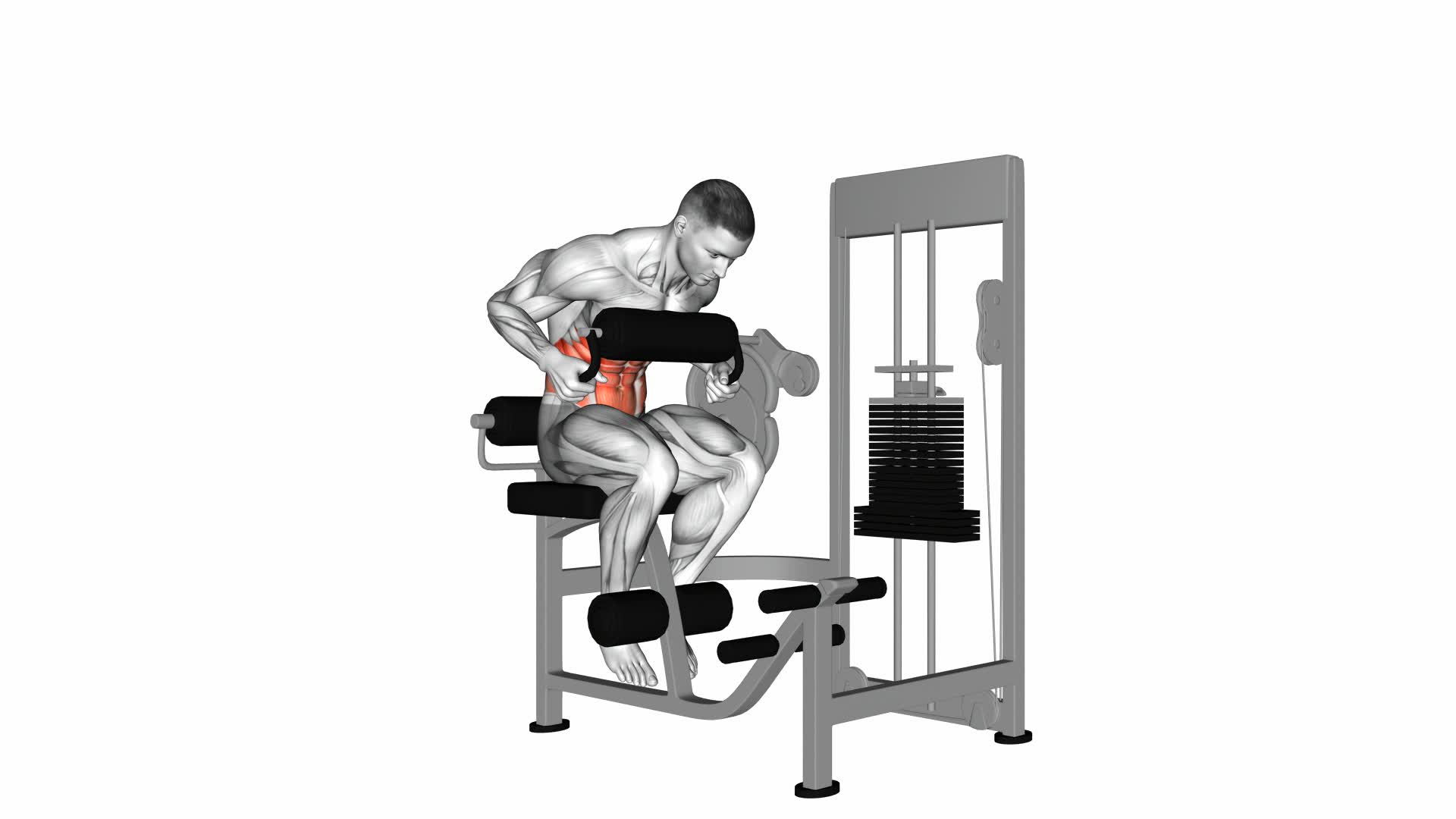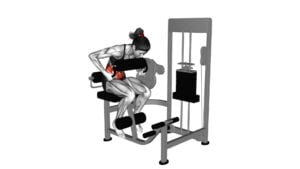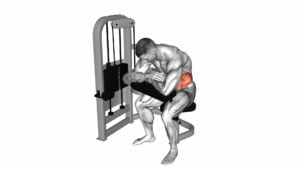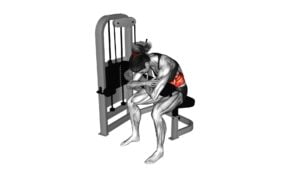Lever Seated Crunch (Chest Pad) – Video Exercise Guide & Tips

Are you looking for a way to strengthen your core and build those ab muscles? Look no further than the lever seated crunch with a chest pad.
Watch This Exercise Video
This exercise targets your abs, obliques, and hip flexors, giving you a solid workout.
In this article, we'll provide you with a video exercise guide and tips to ensure you're performing the move correctly and getting the most out of your workout.
So grab a chest pad and let's get started!
Key Takeaways
- Proper form and technique are crucial for performing the lever seated crunch effectively and safely.
- Using a chest pad improves stability and form, reduces the risk of injury, and helps target the abdominal muscles more effectively.
- The chest pad provides support and helps maintain proper alignment, preventing strain on the neck or shoulders.
- By reducing the risk of injury and allowing for targeted muscle engagement, the lever seated crunch with a chest pad maximizes the benefits for the core muscles.
Proper Form for Lever Seated Crunch
To perform the lever seated crunch correctly, position yourself on the machine and secure your feet under the foot pads. This exercise is great for improving core strength and can be modified to suit your fitness level and goals.
One variation of the lever seated crunch is the decline lever seated crunch, where the bench is set at a decline angle to increase the difficulty. Another variation is the weighted lever seated crunch, where you can hold a weight plate or dumbbell to add resistance and further challenge your core muscles.
To begin the exercise, sit on the machine with your back against the pad and your feet secured. Place your hands behind your head or across your chest, whichever feels more comfortable. Engage your core muscles by pulling your belly button towards your spine.
Slowly lean back, allowing your upper body to curl forward, until you feel a stretch in your abdominals. Then, contract your abs to lift your upper body back up to the starting position. Remember to exhale as you crunch up and inhale as you release back down. Repeat for the desired number of repetitions.
Incorporating variations of crunch exercises, like the lever seated crunch, into your workout routine can help you strengthen your core muscles and improve your overall fitness level.
Benefits of Using a Chest Pad
Using a chest pad during the lever seated crunch exercise offers several benefits.
Firstly, it improves stability and form by providing support to your chest, allowing you to maintain proper alignment throughout the movement.
Secondly, it reduces the risk of injury by minimizing strain on your neck and back, ensuring a safer workout experience.
Lastly, the chest pad helps target your abdominal muscles more effectively, leading to improved muscle engagement and better results.
Improved Stability and Form
Using a chest pad during the lever seated crunch exercise can significantly improve your stability and form. The chest pad provides support and helps to maintain proper alignment throughout the movement. This increased stability allows you to focus on engaging your core muscles effectively, leading to improved core strength.
The chest pad also encourages proper breathing technique, as it helps to keep your upper body in the correct position and prevents you from straining your neck or shoulders. By stabilizing your body and ensuring proper form, the chest pad reduces the risk of injury during the lever seated crunch exercise.
It allows you to perform the exercise with confidence and maximize the benefits for your core muscles.
Reduced Risk of Injury
With the use of a chest pad, you can significantly reduce the risk of injury during the lever seated crunch exercise by maintaining proper form and stability.
The chest pad provides support and stability to your upper body, preventing excessive strain on your back and neck. By keeping your core engaged and your spine aligned, you minimize the risk of muscle imbalances or overextension.
This improved stability allows you to focus on engaging your core muscles effectively, leading to improved core strength over time.
Additionally, the chest pad allows for an increased range of motion, enabling you to fully engage your abdominal muscles without compromising your form.
Targeted Muscle Engagement
To engage your target muscles more effectively, ensure proper form and stability by utilizing a chest pad during the lever seated crunch exercise. This simple addition can provide numerous benefits, including increased core strength and the ability to perform variations for advanced athletes. Here's why using a chest pad can enhance your workout:
- Improved stability: The chest pad helps stabilize your upper body, allowing you to focus solely on engaging your core muscles without unnecessary strain on your back or neck.
- Enhanced muscle activation: By providing support and alignment, the chest pad ensures that your abdominal muscles are properly engaged throughout the entire range of motion.
- Increased resistance: By using a chest pad, you can easily add resistance to the lever seated crunch exercise, making it more challenging and effective for building core strength.
- Advanced variations: With the added stability and support of a chest pad, you can explore advanced variations of the lever seated crunch, such as adding weights or performing the exercise on an incline or decline bench.
- Reduced risk of injury: The chest pad helps maintain proper form and alignment, minimizing the risk of straining or injuring your back or neck during the exercise.
Incorporating a chest pad into your lever seated crunch routine can significantly enhance your targeted muscle engagement, leading to increased core strength and allowing you to progress to more advanced variations.
Targeted Muscles in Lever Seated Crunch
Engage your core and strengthen your abdominal muscles with the Lever Seated Crunch exercise. This exercise primarily targets your rectus abdominis, commonly known as the six-pack muscles. It also engages the internal and external obliques, which are responsible for rotating and stabilizing your torso. The Lever Seated Crunch is an effective exercise for muscle activation and building core strength.
When performing the Lever Seated Crunch, the movement starts by sitting on the machine with your feet secured under the footpads and the chest pad resting against your upper torso. As you crunch forward, your abdominal muscles contract, leading to muscle activation and strengthening. This exercise specifically targets the front and sides of your core, helping to develop stability and improve overall core strength.
By focusing on the correct form and technique, you can optimize the muscle activation and benefits of the Lever Seated Crunch. It's important to avoid common mistakes such as using momentum to swing your body forward or lifting your hips off the seat. These mistakes can reduce the effectiveness of the exercise and increase the risk of injury.
Now that you understand the targeted muscles in the Lever Seated Crunch, let's explore some common mistakes to avoid for proper execution and maximum benefit.
Common Mistakes to Avoid
What are some common mistakes you should avoid when performing the Lever Seated Crunch exercise? Here are five common errors to watch out for:
- Using momentum: One of the most common mistakes people make is using momentum to power through the exercise. This takes away the focus from the targeted muscles and reduces the effectiveness of the workout. Remember to engage your core and perform the movement in a controlled manner.
- Not maintaining proper form: It's important to maintain proper form throughout the exercise. This means keeping your back straight, shoulders relaxed, and not rounding your spine. Incorrect form can put unnecessary stress on your back and increase the risk of injury.
- Neglecting to breathe properly: Breathing is often overlooked during exercises, but it plays a crucial role in maximizing your performance. Remember to exhale as you crunch and inhale as you return to the starting position. This helps stabilize your core and provides oxygen to the working muscles.
- Using too much weight: It's important to choose a weight that allows you to perform the exercise with proper form. Using too much weight can compromise your technique and increase the risk of injury. Start with a lighter weight and gradually increase as you become more comfortable.
- Relying solely on the machine: While the lever seated crunch machine can be a helpful tool, it's important to remember that it's not the only way to work your abs. Incorporating other exercises, such as planks and Russian twists, can help target the muscles from different angles and improve overall core strength.
Tips for Increasing Intensity
To increase the intensity of the Lever Seated Crunch exercise, you can incorporate advanced variations and techniques into your workout routine.
One way to do this is by increasing the resistance. You can achieve this by adding weights to your chest or by using a heavier lever machine. By increasing the resistance, you'll challenge your abdominal muscles even more, leading to greater gains in strength and definition.
Another way to increase the intensity is by incorporating advanced variations of the exercise. One such variation is the twisting lever seated crunch. Instead of just bringing your chest towards your knees, you can also twist your torso from side to side as you crunch. This engages your oblique muscles, providing a more comprehensive workout for your core.
You can also try performing the lever seated crunch with one leg extended. This variation adds an extra challenge to your stability and balance, forcing your core muscles to work harder to maintain control and coordination.
Incorporating these advanced variations and techniques into your Lever Seated Crunch routine will help you take your workout to the next level. Remember to start with lighter weights and gradually increase the resistance as you get stronger. And always listen to your body and adjust the intensity according to your fitness level.
Modifications for Different Fitness Levels
If you're looking to modify the lever seated crunch for different fitness levels, there are a few points to keep in mind.
First, scaling the exercise difficulty can be achieved by adjusting the weight on the machine or using resistance bands.
Additionally, beginners can adapt the exercise by using a lighter weight or performing fewer repetitions.
Scaling Exercise Difficulty
Adjust the lever seated crunch to match your fitness level and maximize your workout intensity. Here are some ways to modify the exercise based on your needs:
- Increase resistance by adding more weight plates to the machine.
- Use advanced modifications such as performing the exercise with one leg raised or with a twist at the top of the movement.
- Slow down the movement to increase time under tension and challenge your muscles further.
- Incorporate pauses at the top or bottom of the movement to add an isometric hold and increase the difficulty.
- Experiment with different tempos, such as performing the exercise at a slower pace or adding explosive movements to make it more challenging.
By making these adjustments, you can ensure that you're continuously challenging yourself and making progress towards your fitness goals.
Remember to listen to your body and adjust accordingly to prevent injury.
Adapting for Beginners
Start by gradually increasing the resistance on the lever seated crunch to match your fitness level and build strength.
Adapting exercises to accommodate different fitness levels is important, especially for beginners.
If you find the lever seated crunch too challenging, there are modifications you can make to make it more manageable.
One option is to reduce the resistance by lowering the weight on the lever machine. This will allow you to focus on proper form and technique before progressing to higher resistance levels.
Another modification is to perform the exercise without any added weight. This can be a great option for beginners who are just starting out and want to build a solid foundation of core strength.
Frequently Asked Questions
How Many Sets and Repetitions Should I Do for Lever Seated Crunches?
For optimal results, you should aim to perform lever seated crunches for about 2-3 sets with 10-15 repetitions per set. This frequency will help target and engage your core muscles effectively.
To add variation and challenge, you can try incorporating different modifications such as holding a weight plate or performing the exercise on an unstable surface like a stability ball.
Remember to maintain proper form and listen to your body to avoid any injuries.
Can I Perform Lever Seated Crunches if I Have Lower Back Pain?
If you have lower back pain, it's important to find alternative core exercises that won't aggravate your condition. Performing lever seated crunches may not be the best choice for you. Instead, focus on exercises that engage your abdominal muscles without putting strain on your lower back.
Some alternatives you can try are planks, bird dogs, or seated knee tucks. Remember to listen to your body and consult with a healthcare professional for personalized advice.
Should I Use Additional Weights While Doing Lever Seated Crunches?
When it comes to lever seated crunches, adding weights can provide several benefits. Incorporating additional weights challenges your muscles and helps increase strength and muscle tone. It can also enhance the effectiveness of the exercise and promote greater calorie burn.
However, if you prefer not to use weights, there are alternatives that can still give you a challenging workout. You can increase the number of repetitions, focus on slow and controlled movements, or try different variations of the exercise.
Can I Do Lever Seated Crunches on a Regular Bench Instead of a Chest Pad?
Yes, you can try doing lever seated crunches on a regular bench as an alternative exercise. However, keep in mind that using a chest pad provides better support and stability for your upper body.
Lever seated crunches are specifically designed to target your abdominal muscles and using a chest pad helps to isolate the movement.
How Long Should I Rest Between Sets of Lever Seated Crunches?
To maximize the effectiveness of your lever seated crunches, it's important to give yourself enough rest time between sets.
The ideal rest time for this exercise can vary depending on your fitness level and goals. Generally, a good rule of thumb is to rest for about 30-60 seconds between sets.
However, if you're looking to increase the intensity, you can decrease the rest time to 15-30 seconds or even perform variations of the exercise to challenge your core muscles even more.
Conclusion
In conclusion, the lever seated crunch with a chest pad is an effective exercise for targeting the core muscles. By maintaining proper form and using the chest pad, you can increase the intensity of the exercise and avoid common mistakes.
Whether you're a beginner or an advanced fitness enthusiast, there are modifications available to suit your fitness level. Incorporate this exercise into your routine to strengthen your core and improve overall fitness.

Author
Years ago, the spark of my life’s passion ignited in my mind the moment I stepped into the local gym for the first time. The inaugural bead of perspiration, the initial endeavor, the very first surge of endorphins, and a sense of pride that washed over me post-workout marked the beginning of my deep-seated interest in strength sports, fitness, and sports nutrition. This very curiosity blossomed rapidly into a profound fascination, propelling me to earn a Master’s degree in Physical Education from the Academy of Physical Education in Krakow, followed by a Sports Manager diploma from the Jagiellonian University. My journey of growth led me to gain more specialized qualifications, such as being a certified personal trainer with a focus on sports dietetics, a lifeguard, and an instructor for wellness and corrective gymnastics. Theoretical knowledge paired seamlessly with practical experience, reinforcing my belief that the transformation of individuals under my guidance was also a reflection of my personal growth. This belief holds true even today. Each day, I strive to push the boundaries and explore new realms. These realms gently elevate me to greater heights. The unique combination of passion for my field and the continuous quest for growth fuels my drive to break new ground.







